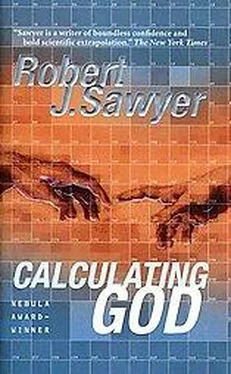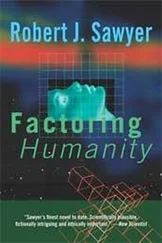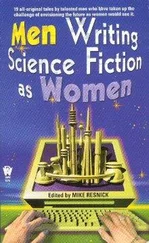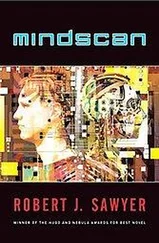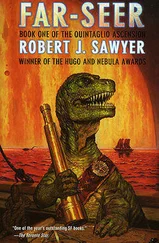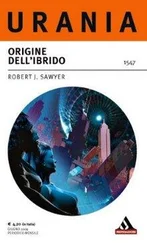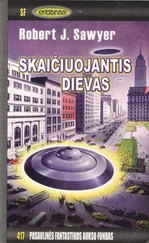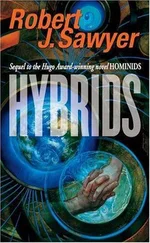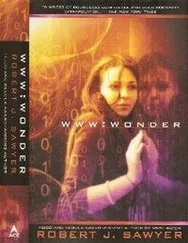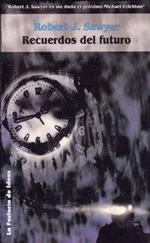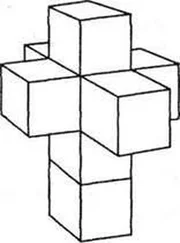Robert Sawyer - Calculating God
Здесь есть возможность читать онлайн «Robert Sawyer - Calculating God» весь текст электронной книги совершенно бесплатно (целиком полную версию без сокращений). В некоторых случаях можно слушать аудио, скачать через торрент в формате fb2 и присутствует краткое содержание. Город: New York, Год выпуска: 2000, Издательство: Tor Books, Жанр: Фантастика и фэнтези, на английском языке. Описание произведения, (предисловие) а так же отзывы посетителей доступны на портале библиотеки ЛибКат.
- Название:Calculating God
- Автор:
- Издательство:Tor Books
- Жанр:
- Год:2000
- Город:New York
- ISBN:нет данных
- Рейтинг книги:5 / 5. Голосов: 1
-
Избранное:Добавить в избранное
- Отзывы:
-
Ваша оценка:
- 100
- 1
- 2
- 3
- 4
- 5
Calculating God: краткое содержание, описание и аннотация
Предлагаем к чтению аннотацию, описание, краткое содержание или предисловие (зависит от того, что написал сам автор книги «Calculating God»). Если вы не нашли необходимую информацию о книге — напишите в комментариях, мы постараемся отыскать её.
Calculating God — читать онлайн бесплатно полную книгу (весь текст) целиком
Ниже представлен текст книги, разбитый по страницам. Система сохранения места последней прочитанной страницы, позволяет с удобством читать онлайн бесплатно книгу «Calculating God», без необходимости каждый раз заново искать на чём Вы остановились. Поставьте закладку, и сможете в любой момент перейти на страницу, на которой закончили чтение.
Интервал:
Закладка:
But the invert gallery had been closed ages ago, and in 1999 the space was reopened to the public as “The Discovery Gallery,” precisely the kind of edutainment mind-candy Christine Dorati likes: interactive displays for kids, with almost no real learning going on. The subway-poster ads for the new gallery bore the slogan, “Imagine if the Museum were run by an eight-year-old.” As John Lennon once said, it’s easy if you try.
Our pride and joy in vert paleo is our duckbilled Parasaurolophus skeleton, with its glorious, meter-long head crest. Every specimen you’ve ever seen anywhere in the world is a cast of our mount. Indeed, even the Discovery Gallery contains a cast of our Parasaurolophus, lying on the floor, embedded in fake matrix. Kids whack at it all day long with wooden mallets and chisels, mostly resting their bums on the magnificent skull.
Just out front of the vert-paleo gallery there is an indoor balcony, looking down on the Rotunda, which has a subtle star-burst design laid into its marble floor. There’s another balcony on the opposite side, out front of the Discovery Gallery. Between the two, above the glass-doored main entrance, are three vertical stained-glass windows.
While the museum was closed to the public, I took Hollus through the vert-paleo gallery. We’ve got the best collection of hadrosaurs in the world. We’ve also got a dramatic Albertosaurus, a formidable Chasmosaurus, two dynamic mounts of Allosaurus, an excellent Stegosaurus, plus a Pleistocene-mammals display, a wall covered with casts of primate and hominid remains, a La Brea tar-pits exhibit, a standard evolution-of-the-horse sequence, and a wonderful late-Cretaceous underwater diorama, with plesiosaurs, mosasaurs, and ammonites.
I also took Hollus over to the hated Discovery Gallery, where a cast of a T. rex looms over the hapless, floor-mounted Parasaurolophus. Hollus seemed enchanted by all the fossils.
In addition, I showed him a lot of paintings of dinosaurs as they might have looked while alive, and I had Abdus go get a copy of Jurassic Park on video so Hollus could watch that.
We also spent a lot of time with crusty old Jonesy, going through the invertebrate-paleo collections; Jonesy’s got trilobites up the wazoo.
But, I decided, fair is fair. Hollus had said at the outset that he would share information his people had gathered. It was time to start collecting on that. I asked him to tell me about the evolutionary history of lifeforms on his world.
I’d assumed he was going to send down a book, but he did more.
Much more.
Hollus said he needed some room to do it properly, so we waited until the museum closed for the day. The simulacrum wavered briefly in my office, then disappeared. We found it easier for me to just carry the holoform projector from place to place than for the simulacrum to walk with me through the corridors of the museum, since almost everyone — curator, grad student, janitor, patron — found an excuse to stop us and chat with the alien.
I took the staff elevator down to the main floor, to the wide stone staircase that wound around the Nisga’a totem pole to the basement. Directly below the main Rotunda was what we imaginatively referred to as the Lower Rotunda. This large, open space, painted the color of cream-of-tomato soup, served as the lobby for Theatre ROM, which was located beneath the gift shops of the first floor.
I’d had support staff set up five video cameras on tripods, to record what Hollus was going to show me — I knew that he didn’t want people looking over his eight shoulders when he was doing his work; but he understood that when he was giving information to us as payment, we had to make a record of it. I placed the holoform projector in the middle of the wide floor and tapped on it to summon the Forhilnor genie. Hollus reappeared, and I heard his language for the first time as he gave further instructions to the projector. It was like a little song, with Hollus harmonizing with himself.
Suddenly the lobby was replaced with an incredible alien vista. Just as with the simulacrum of Hollus, I couldn’t tell that this wasn’t real; it was as though I’d been teleported across two dozen light-years to Beta Hydri III.
“This is a simulation, of course,” said Hollus, “but we believe it to be accurate, although the coloration of the animals is conjecture. This is how my world appeared seventy million of your years ago, just prior to the most recent mass extinction.”
My pulse thundered in my ears. I stomped my feet, feeling the reassuring solidness of the Lower Rotunda’s floor, the only evidence that I was still in Toronto.
The sky was as cerulean as Earth’s sky, and the clouds were cumulonimbus; the physics of a nitrogen-oxygen atmosphere laden with water vapor were apparently universal. The landscape consisted of gently rolling hills, and there was a large pond, limned by sand, located about where the base of the Nisga’a totem pole really is. The sun was the same pale yellow as Sol and appeared about the same size as our sun did to us. I’d looked up Beta Hydri in a reference book: it was 1.6 times as wide as Sol, and 2.7 times as bright, so the Forhilnor homeworld must have orbited it at a greater distance than Earth orbits our sun.
The plants were all green — chlorophyll, another compound Hollus argued showed signs of intelligent design, was the best chemical for its job no matter what world you were on. The things that served the purpose of leaves were perfectly round and supported from beneath by a central stalk. And instead of having bark over whatever the wood-equivalent was, the trunks were encased in a translucent material, similar to the crystal that covered Hollus’s eyes.
Hollus was still visible, standing next to me. Few of the animals I saw seemed to be based on the same body plan as he was, although on those that were, the eight limbs were undifferentiated: all were used for locomotion; none for manipulation. But most of the lifeforms seemed to have five limbs, not eight — presumably these were the ectothermic pentapeds Hollus had referred to earlier. Some of the pentapeds had enormously long legs, raising their torsos to great heights. Others had limbs so stubby that the torsos dragged along the ground. I watched, astounded, as one pentaped used its five legs to kick an octoped into unconsciousness, then lowered its torso, which apparently had a mouth on its underside, down onto the body.
Nothing flew in the blue sky, although I did see pentapeds I dubbed “parasols” with membranes stretched between each of their five limbs. They parachuted down from trees, seemingly able to control their descent by moving specific limbs closer together or farther apart; their goal appeared to be to land on the backs of pentapeds or octopeds, killing them with poisonous ventral prongs.
None of the animals I saw had eyestalks like Hollus’s; I wondered if they had evolved later specifically to allow animals to see if a parasol was waiting to sail down on them. Evolution was, after all, an arms race.
“It’s incredible,” I said. “A completely alien ecosystem.”
I rather imagine that Hollus was amused. “That is much as I felt when I first arrived here. Even though I had seen other ecosystems, there is nothing more amazing than encountering a different set of lifeforms and seeing how they interact.” He paused. “As I said, this is my world as it would have been seventy million of your years ago. When the next extinction event happens, the pentapeds will all be wiped out.”
I watched a midsized pentaped attacking a slightly smaller octoped. The blood was every bit as red as terrestrial blood, and the cries of the dying creature, although two toned, coming in alternating anguish from separate mouths, sounded just as terrified.
Читать дальшеИнтервал:
Закладка:
Похожие книги на «Calculating God»
Представляем Вашему вниманию похожие книги на «Calculating God» списком для выбора. Мы отобрали схожую по названию и смыслу литературу в надежде предоставить читателям больше вариантов отыскать новые, интересные, ещё непрочитанные произведения.
Обсуждение, отзывы о книге «Calculating God» и просто собственные мнения читателей. Оставьте ваши комментарии, напишите, что Вы думаете о произведении, его смысле или главных героях. Укажите что конкретно понравилось, а что нет, и почему Вы так считаете.
